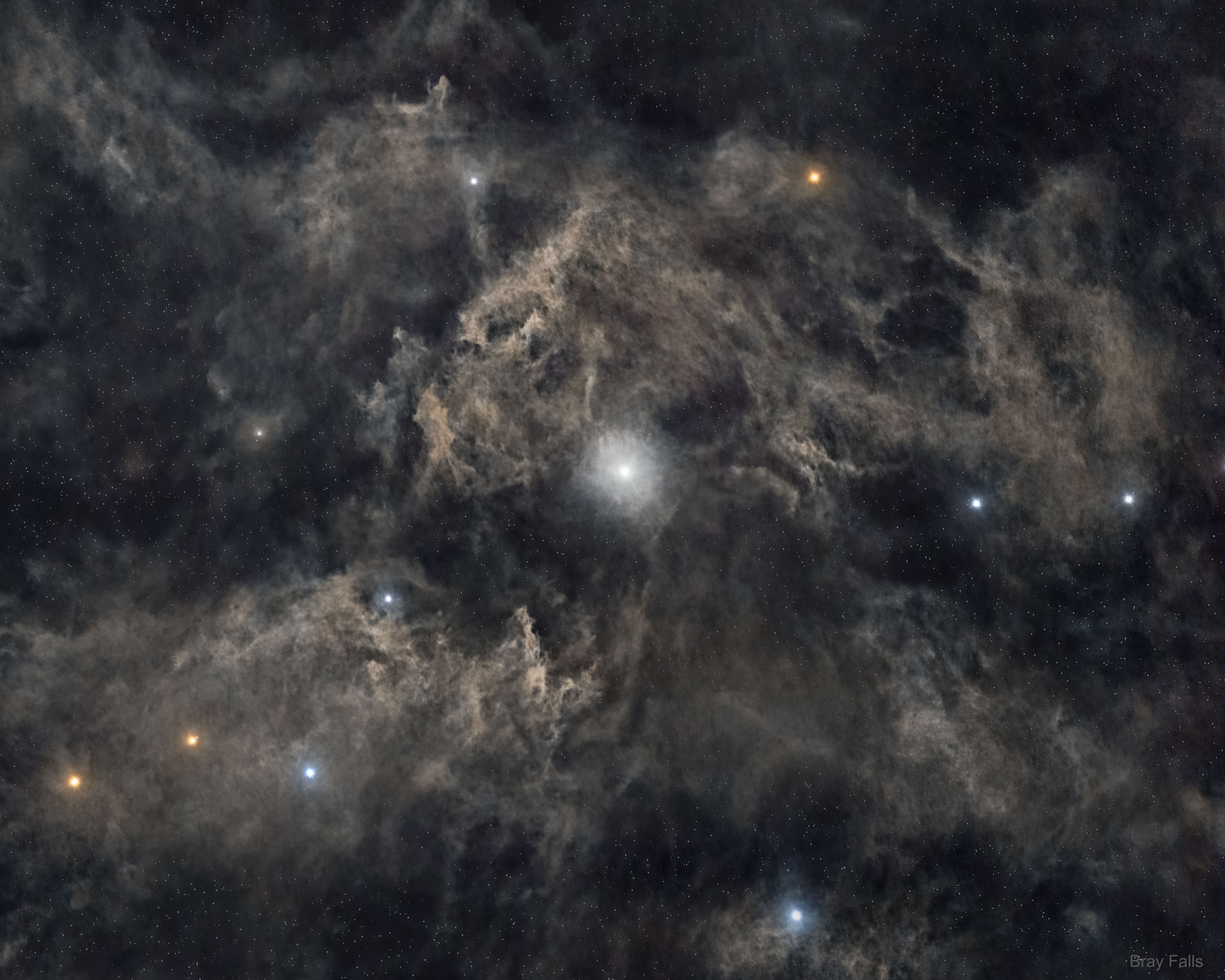28. April 2021
北方 ê 恆星:北極星 kah 邊仔 ê 塗粉

探索宇宙1!逐工會揀一幅無仝款 ê 影像抑是相片,𤆬你熟似咱這个迷人 ê 宇宙,閣有專業天文學者2為你3解說4。
- 原始文章:North Star: Polaris and Surrounding Dust
- 影像來源 kah 版權:Bray Falls
- 台文翻譯:An-Li Tsai (NCU)
- 宇宙入口:APOD 亂數產生器
[漢羅] 北方 ê 恆星:北極星 kah 邊仔 ê 塗粉
是按怎 北極星 會號做北極星? 上主要 ê 原因是,北極星是 tī 地球 自轉軸 北爿離咱上近 較光 ê 恆星。 所以,當地球 leh 自轉 ê 時陣,恆星 to̍h 會踅北極星行,毋閣北極星會一直 chhāi tī 遐袂振袂動。 這就是伊成做 北極星 ê 原因。 因為 tī 自轉軸南爿 附近無較光 ê 恆星,所以咱這馬 to̍h 無 南極星。 幾若千年前,地球 ê 自轉軸指向小可仔無仝 ê 方向。 彼當陣 ê 北極星是織女星。 雖然講北極星毋是天頂上光 ê 星,毋閣伊足好揣 ê。 因為伊差不多 kah 北斗星 khat-á 內底 ê 兩粒星排仝排。 北極星 差不多 to̍h tī 這幅 8 度闊 ê 影像 中央。 是一个用 數位處理 ê 方式 kā 較暗 ê 恆星光壓制,加強 星系間星雲 (IFN) 內底較暗 ê 氣體 kah 塗粉 ê 光度。 北極星是一粒 造父變星,伊 ê 表面 to̍h 沓沓仔 噗噗跳,予伊 ê 光度 tī 幾若工內變化幾若葩。
[POJ] Pak-hong ê hêng-chhiⁿ: Pak-ke̍k-chhiⁿ kah piⁿ-á ê thô͘-hún
Sī án-ná Pak-ke̍k-chhiⁿ ē hō chòe Pak-ke̍k-chhiⁿ? Siōng chú-iàu ê goân-in sī, Pak-ke̍k-chhiⁿ sī tī Tē-kiû chū-choán-te̍k pak-pêng lî lán siōng-kīn khah-kng ê hêng-chhiⁿ. Só͘-í, tng Tē-kiû leh chū-choán ê sî-chūn, hêng-chhiⁿ to̍h ē se̍h Pak-ke̍k-chhiⁿ kiâⁿ, m̄-koh Pak-ke̍k-chhiⁿ ē it-ti̍t chhāi tī hiah bōe-tín-bōe-tāng. Che tio̍h sī i chiâⁿ-chòe Pak-ke̍k-chhiⁿ ê goân-in. In-ūi tī chū-choán-te̍k lâm-pêng hū-kīn bô khah-kng ê hêng-chhiⁿ, só͘-í lán chit-má to̍h bô Lâm-ke̍k-chhiⁿ. Kúi-ā chheng nî chêng, Tē-kiû ê chū-choán-te̍k chí-hiòng sió-khóa-á bô-kâng ê hong-hiòng. Hit-tang-chūn ê Pak-ke̍k-chhiⁿ sī Chit-lú-chhiⁿ. Sui-jiân-kóng Pak-ke̍k-chhiⁿ m̄-sī thiⁿ-téng siōng-kng ê chhiⁿ, m̄-koh i chiok hó chhoe ê. In-ūi i chha-put-to kah Pak-táu-chhiⁿ khat-á lāi-té ê nn̄g-lia̍p chhiⁿ pái kāng pâi. Pak-ke̍k-chhiⁿ chha-put-to to̍h tī chit-pak poeh tō͘ khoah ê iáⁿ-siōng tiong-ng. Sī chi̍t-ê iōng só͘-ūi-chhú-lí ê hong-sek kā khah-àm ê hêng-chhiⁿ-kng ap-chè, ka-kiông Seng-hē-kan-seng-hûn (IFN) lāi-té khah-àm ê khì-thé kah thô͘-hún ê kng-tō͘. Pak-ke̍k-chhiⁿ sī chi̍t-lia̍p Chō-hū-piàn-chhiⁿ, i ê piáu-bīn to̍h tau̍h-tau̍h-á phok-phok-thiàu, hō͘ i ê kng-tō͘ tī kúi-ā kang lāi piàn-hòa kúi-ā pha.
[KIP] Pak-hong ê hîng-tshinn: Pak-ki̍k-tshinn kah pinn-á ê thôo-hún
Sī án-ná Pak-ki̍k-tshinn ē hō tsuè Pak-ki̍k-tshinn? Siōng tsú-iàu ê guân-in sī, Pak-ki̍k-tshinn sī tī Tē-kiû tsū-tsuán-ti̍k pak-pîng lî lán siōng-kīn khah-kng ê hîng-tshinn. Sóo-í, tng Tē-kiû leh tsū-tsuán ê sî-tsūn, hîng-tshinn to̍h ē se̍h Pak-ki̍k-tshinn kiânn, m̄-koh Pak-ki̍k-tshinn ē it-ti̍t tshāi tī hiah buē-tín-buē-tāng. Tse tio̍h sī i tsiânn-tsuè Pak-ki̍k-tshinn ê guân-in. In-uī tī tsū-tsuán-ti̍k lâm-pîng hū-kīn bô khah-kng ê hîng-tshinn, sóo-í lán tsit-má to̍h bô Lâm-ki̍k-tshinn. Kuí-ā tshing nî tsîng, Tē-kiû ê tsū-tsuán-ti̍k tsí-hiòng sió-khuá-á bô-kâng ê hong-hiòng. Hit-tang-tsūn ê Pak-ki̍k-tshinn sī Tsit-lú-tshinn. Sui-jiân-kóng Pak-ki̍k-tshinn m̄-sī thinn-tíng siōng-kng ê tshinn, m̄-koh i tsiok hó tshue ê. In-uī i tsha-put-to kah Pak-táu-tshinn khat-á lāi-té ê nn̄g-lia̍p tshinn pái kāng pâi. Pak-ki̍k-tshinn tsha-put-to to̍h tī tsit-pak pueh tōo khuah ê iánn-siōng tiong-ng. Sī tsi̍t-ê iōng sóo-uī-tshú-lí ê hong-sik kā khah-àm ê hîng-tshinn-kng ap-tsè, ka-kiông Sing-hē-kan-sing-hûn (IFN) lāi-té khah-àm ê khì-thé kah thôo-hún ê kng-tōo. Pak-ki̍k-tshinn sī tsi̍t-lia̍p Tsō-hū-piàn-tshinn, i ê piáu-bīn to̍h ta̍uh-ta̍uh-á phok-phok-thiàu, hōo i ê kng-tōo tī kuí-ā kang lāi piàn-huà kuí-ā pha.
[English] North Star: Polaris and Surrounding Dust
Why is Polaris called the North Star? First, Polaris is the nearest bright star toward the north spin axis of the Earth. Therefore, as the Earth turns, stars appear to revolve around Polaris, but Polaris itself always stays in the same northerly direction -- making it the North Star. Since no bright star is near the south spin axis of the Earth, there is currently no South Star. Thousands of years ago, Earth's spin axis pointed in a slightly different direction so that Vega was the North Star. Although Polaris is not the brightest star on the sky, it is easily located because it is nearly aligned with two stars in the cup of the Big Dipper. Polaris is near the center of the eight-degree wide featured image, an image that has been digitally manipulated to suppress surrounding dim stars but accentuate the faint gas and dust of the Integrated Flux Nebula (IFN). The surface of Cepheid Polaris slowly pulsates, causing the star to change its brightness by a few percent over the course of a few days.
詞彙學習
| 漢羅 | POJ | KIP | 華語 | English |
|---|---|---|---|---|
| 北極星 | Pak-ke̍k-chhiⁿ | Pak-ki̍k-tshinn | 北極星 | Polaris, North Star |
| 自轉軸 | chū-choán-te̍k | tsū-tsuán-ti̍k | 自轉軸 | spin axis |
| 南極星 | Lâm-ke̍k-chhiⁿ | Lâm-ki̍k-tshinn | 南極星 | South Star |
| 織女星 | Chit-lú-chhiⁿ | Tsit-lú-tshinn | 織女星 | Vega |
| 北斗星 | Pak-táu-chhiⁿ | Pak-táu-tshinn | 北斗七星 | Big Dipper |
| 星系間星雲 | Seng-hē-kan Seng-hûn | Sing-hē-kan Sing-hûn | 共同照耀星雲 | Integrated Flux Nebula (IFN) |
| 造父變星 | Chō-hū-piàn-chhiⁿ | Tsō-hū-piàn-tshinn | 造父變星 | Cepheid |